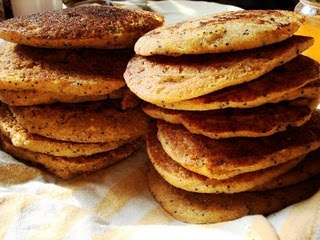Basic Soy Yogurt
>> Saturday, February 21
Yogurt making is so simple I didn’t really believe I had managed it the first time. All you are doing is creating a good environment for your bacteria (clean, warm, and with something they can eat) and letting them do the rest. So the only things you need to worry about are cleanliness (wash all your materials and don’t lick the spoon) and temperature.
MILK: Soy yogurt is only slightly more tricky, and mainly because quality and ingredients in commercial soymilk can vary. In general, I think it is better to buy organic soymilk with no additives or sweeteners, and to check to see if it was made from whole soybeans or from soy flour. Don’t buy milk that was made from flour, that’s just not how you make grain milks and it creeps me out! If you use a sweetened milk, the safest sweeteners are sugar or cane juice. Others can interfere with the bacterial growth, although I would like to see if molasses works, and I’ll post as soon as I know. You can always add a sweetener later!
TEMPERATURE: It took me some experimenting to find that the temperature is also a more sensitive issue with soy, and if your milk is too hot, it will curdle immediately. In this respect, it is always better to err on the side of cool if you don’t know how warm to make the milk-if it’s too cold to help the bacteria grow a lot, you can usually just wait longer and it will eventually reach the right thickness.
The third thing is that incubation times can vary a LOT and I’m really not sure why. I am guessing it is mostly the temperature it stays at while thickening, and if it stays a nice constant temperature, it works much faster. You are working with little bacteria that in some ways act like people-they slow down if it’s cold or really hot. Lately I have let mine sit for a minimum of 9 hours. Then I check the thickness by jiggling the jar a little, or tilting it lightly, and if I want it thicker, I leave it. If you leave it for too long, like 24 hours or so, you get a lot of separation, but it is still totally edible.
CLEANLINESS: Wash all your materials beforehand with soap and again with just hot water. Never touch things with your hands before the milk or yogurt touches them, and don’t dip your fingers in the yogurt or milk. It’s a good idea to cover the yogurt with something when it is incubating to keep other organisms out.
I have never used a powdered or liquid culture started for my yogurt, I just look for a good live yogurt in the shop and use the last of it. It will work either way though, and you can do what works for you
So, my tips for making good soy yogurt:
Be clean
Use plain, good quality, organic “whole-bean” soymilk
Don’t overheat the milk
Don’t move the jar during incubation
Keep the yogurt as warm as you can while it sits
All that being said, I should add that I have made yogurt in all kinds of places at all kinds of temperatures, and the worst that can happen is you have a jar of milk at the end, which is exactly what you started with. Don’t worry, it’s forgiving ☺
Basic Soy Yogurt
Makes 1 liter
Ingredients:
Slightly less than one liter of soy milk (1 liter minus about 4 tbsp)
4 tbsp plain, live, cultured soy yogurt
Materials:
1 liter glass jar
medium saucepan
a thick kitchen towel, a big cooking pot (or yogurt incubator), an insulated lunchbox, or something else to put the yogurt in to keep it warm.
a long spoon or other stirrer
Directions:
Before beginning, thoroughly wash all tools and containers and rinse in super-hot water.
Put the yogurt in the jar
Over a low flame, heat the milk, stirring. Test the temperature by letting a drop fall from the spoon onto your wrist (and don’t let it fall from your wrist into the pan, you want things clean!). The milk should feel very warm, but not at all uncomfortable; it doesn’t take long, so watch it!
When the milk is ready, put a few spoonfuls of milk into the yogurt and combine. (If it curdles, your milk was too hot and you can continue knowing you will have very lumpy yogurt, or start over with fresh yogurt)
Add the rest of the milk and slowly stir together, combining thoroughly. Set the jar in a warm place where it won’t be moved; a covered pot of water the same temperature as the milk, or inside an insulated lunchbox with a jar of warm water next to it to keep the temperature up. If you have a warm enough spot (like next to where you are cooking, if you will cook a lot that day) you can wrap the yogurt in a towel and leave it there.
Let the yogurt incubate for at least 8 hours, check the thickness and let sit for a few more hours if it’s too thin. When it’s finished, put the yogurt in the fridge to slow bacterial growth.







0 comments:
Post a Comment